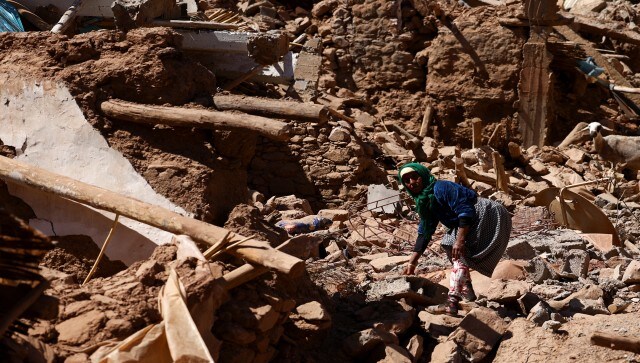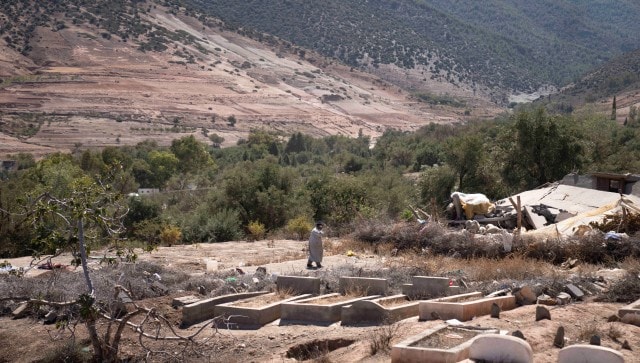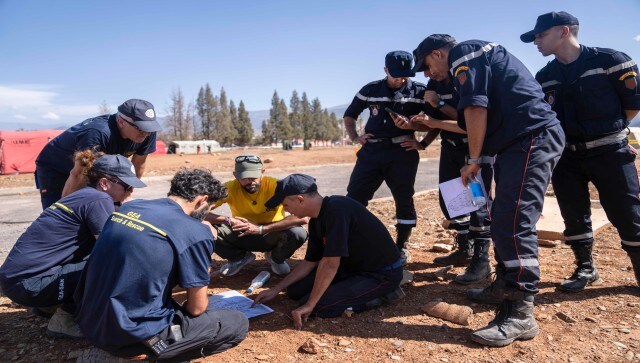A strong earthquake shook Marrakech, the fourth-largest city in Morocco, on Friday late night. According to estimates, there have been more than 2,500 fatalities and more injuries, and this number will likely increase as additional towns and villages high in the mountains remain inaccessible. Numerous historical sites, including UNESCO World Heritage sites, have also been impacted in addition to the human toll. According to CNN, eyewitnesses in the lower mountain regions informed that numerous isolated settlements have been entirely destroyed. Let’s take a closer look. Also read: Why the Morocco earthquake was so devastating UNESCO sites destroyed The old city of Marrakech has reportedly been badly devastated, however, the amount of the destruction is still unknown. Since 1985, the Medina of Marrakech, a UNESCO World Heritage Site, has housed structures that date back to the 11th century, when the Almoravid dynasty transformed the settlement into a political, economic, and cultural hub that had an impact on the entire western Muslim world. [caption id=“attachment_13113262” align=“alignnone” width=“640”] Khadijah Deaoune stands in the rubble, where her house once stood, as she tries to rescue her goat after the deadly earthquake in Tinmel, Morocco. Reuters[/caption] Eric Falt, the regional director of the UNESCO Office for the Maghreb, told The Art Newspaper that “it can already be said that the damage is much more significant than expected.” The Koutoubiya Mosque, the Kasbah, a walled structure that comprises the royal palace, the battlements, colossal entrances, and gardens, are just a few of the monuments from that era that can be found at the location, according to the report. Other architectural features include the Bandia Palace, the Ben Youssef Madrasa, the Saadian Tombs, and the open-air theatre at Place Jamaa El Fna. According to Aljazeera, the revered Koutoubiya Mosque’s 69-meter-tall tower, known as “Marrakech’s roof,” appeared to be unharmed, while other media sources indicate that the minaret has sustained significant cracks. The minaret of the Kharboush mosque, which is situated on a prominent Jemaa el-Fna square corner, has collapsed, putting the mosque’s entire structure in jeopardy. According to media reports, the famed red sandstone walls that encircle the ancient city have also suffered major damage in some areas, and the obstruction of passageways by rubble and debris has made it challenging for rescue crews to reach the scene. A noteworthy structure of Almohad architecture, the 12th-century Tinmel mosque, which was 100 kilometres southeast of Marrakech, was also destroyed, as per Reuters. The mosque, which was previously a popular pilgrimage destination, had undergone partial restoration in the middle of the 20th century and again in the 1990s, and it has been included on UNESCO’s Tentative World Heritage List since 1995, as per The Art Newspaper. A repair project that was to span 18 months and included plans for a new museum close to the site was started by the Ministry of Islamic Affairs just seven months ago. Dr Ismail Shaouf, the deputy chairperson of the provincial council of Marrakesh told The National News that portions of the city’s walls that enclose and divide its historic from modern neighbourhoods have been destroyed. “This is a great loss for heritage, world’s heritage, and Marrakesh in particular,” he remarked. The earthquake also had an impact on the UNESCO-listed Ksar of At Ben Haddou, a walled city on the former caravan route between the Sahara and Marrakech where scenes from the 1962 film Lawrence of Arabia were filmed in part. The newspaper quoted Falt as saying, “It is difficult to have a precise inventory (of the damage done). But photos show damaged and cracked buildings. The collective granary which overlooks the ksar was reportedly seriously damaged." The city is regarded as a model for Moroccan mud clay architecture. Also read: Morocco earthquake: Why tourists are not cancelling their travel plans Modern parts The impact has barely been felt in Marrakech’s modern areas. However, it was in the High Atlas Mountains’ outlying regions where the biggest destruction took place. The Al Haouz Province, well-known for the picturesque towns scattered over the mountain range, has been among the worst hit. [caption id=“attachment_13113342” align=“alignnone” width=“640”]
Khadijah Deaoune stands in the rubble, where her house once stood, as she tries to rescue her goat after the deadly earthquake in Tinmel, Morocco. Reuters[/caption] Eric Falt, the regional director of the UNESCO Office for the Maghreb, told The Art Newspaper that “it can already be said that the damage is much more significant than expected.” The Koutoubiya Mosque, the Kasbah, a walled structure that comprises the royal palace, the battlements, colossal entrances, and gardens, are just a few of the monuments from that era that can be found at the location, according to the report. Other architectural features include the Bandia Palace, the Ben Youssef Madrasa, the Saadian Tombs, and the open-air theatre at Place Jamaa El Fna. According to Aljazeera, the revered Koutoubiya Mosque’s 69-meter-tall tower, known as “Marrakech’s roof,” appeared to be unharmed, while other media sources indicate that the minaret has sustained significant cracks. The minaret of the Kharboush mosque, which is situated on a prominent Jemaa el-Fna square corner, has collapsed, putting the mosque’s entire structure in jeopardy. According to media reports, the famed red sandstone walls that encircle the ancient city have also suffered major damage in some areas, and the obstruction of passageways by rubble and debris has made it challenging for rescue crews to reach the scene. A noteworthy structure of Almohad architecture, the 12th-century Tinmel mosque, which was 100 kilometres southeast of Marrakech, was also destroyed, as per Reuters. The mosque, which was previously a popular pilgrimage destination, had undergone partial restoration in the middle of the 20th century and again in the 1990s, and it has been included on UNESCO’s Tentative World Heritage List since 1995, as per The Art Newspaper. A repair project that was to span 18 months and included plans for a new museum close to the site was started by the Ministry of Islamic Affairs just seven months ago. Dr Ismail Shaouf, the deputy chairperson of the provincial council of Marrakesh told The National News that portions of the city’s walls that enclose and divide its historic from modern neighbourhoods have been destroyed. “This is a great loss for heritage, world’s heritage, and Marrakesh in particular,” he remarked. The earthquake also had an impact on the UNESCO-listed Ksar of At Ben Haddou, a walled city on the former caravan route between the Sahara and Marrakech where scenes from the 1962 film Lawrence of Arabia were filmed in part. The newspaper quoted Falt as saying, “It is difficult to have a precise inventory (of the damage done). But photos show damaged and cracked buildings. The collective granary which overlooks the ksar was reportedly seriously damaged." The city is regarded as a model for Moroccan mud clay architecture. Also read: Morocco earthquake: Why tourists are not cancelling their travel plans Modern parts The impact has barely been felt in Marrakech’s modern areas. However, it was in the High Atlas Mountains’ outlying regions where the biggest destruction took place. The Al Haouz Province, well-known for the picturesque towns scattered over the mountain range, has been among the worst hit. [caption id=“attachment_13113342” align=“alignnone” width=“640”] A man walks past a cemetery where people who were killed by the earthquake were buried, in the village of Tafeghaghte, near Marrakech, Morocco. AP[/caption] According to The Associated Press, locals in the village of Ijjoukak, which is close to North Africa’s tallest mountain peak, believe that 200 buildings have been entirely levelled. The fact that many of the settlements are remote and challenging to reach makes providing first aid much harder. Restoration project Falt told The Art Newspaper that UNESCO hopes to send a team to assess the damage to the building soon. He also emphasised its importance, saying, “It’s a symbolic place in the history of Morocco because it was the starting point of the Almohad military campaigns against the Almoravid dynasty, at the beginning of the 12th century.” Its destruction, Falt believes, “constitutes an inestimable loss for the national heritage of Morocco.” While speaking to Morocco’s Medias24, the keeper of the site, Nadia El Bourakkadi said, “The mosque survived for centuries. It’s the will of God.” According to Reuters, a Moroccan culture ministry source said “the ministry has decided to restore it and will make a budget for it”, without giving details. Also read: Morocco survivors seek aid as quake toll of 2,000 is expected to rise The quake The National Centre for Scientific and Technical Research in Rabat, the country’s capital, determined the earthquake’s magnitude to be 7.0. The devastation it caused to neighbouring cities was caused by its epicentre, which was situated in Al Haouz Province, around 70 kilometres (44 miles) south of Marrakesh. A total of 2,681 people were confirmed dead, with nearly 1,600 of them from the hardest-hit Al Haouz province, the Moroccan Interior Ministry reported on Monday. Nearly all the dead have already been buried, the government reported. More than 2,500 people were injured, reported AP. Apart from Marrakesh, the earthquake was felt in cities across the country, including Rabat, the country’s largest city of Casablanca, as well as coastal cities such as Agadir and Essaouira. [caption id=“attachment_13113332” align=“alignnone” width=“640”]
A man walks past a cemetery where people who were killed by the earthquake were buried, in the village of Tafeghaghte, near Marrakech, Morocco. AP[/caption] According to The Associated Press, locals in the village of Ijjoukak, which is close to North Africa’s tallest mountain peak, believe that 200 buildings have been entirely levelled. The fact that many of the settlements are remote and challenging to reach makes providing first aid much harder. Restoration project Falt told The Art Newspaper that UNESCO hopes to send a team to assess the damage to the building soon. He also emphasised its importance, saying, “It’s a symbolic place in the history of Morocco because it was the starting point of the Almohad military campaigns against the Almoravid dynasty, at the beginning of the 12th century.” Its destruction, Falt believes, “constitutes an inestimable loss for the national heritage of Morocco.” While speaking to Morocco’s Medias24, the keeper of the site, Nadia El Bourakkadi said, “The mosque survived for centuries. It’s the will of God.” According to Reuters, a Moroccan culture ministry source said “the ministry has decided to restore it and will make a budget for it”, without giving details. Also read: Morocco survivors seek aid as quake toll of 2,000 is expected to rise The quake The National Centre for Scientific and Technical Research in Rabat, the country’s capital, determined the earthquake’s magnitude to be 7.0. The devastation it caused to neighbouring cities was caused by its epicentre, which was situated in Al Haouz Province, around 70 kilometres (44 miles) south of Marrakesh. A total of 2,681 people were confirmed dead, with nearly 1,600 of them from the hardest-hit Al Haouz province, the Moroccan Interior Ministry reported on Monday. Nearly all the dead have already been buried, the government reported. More than 2,500 people were injured, reported AP. Apart from Marrakesh, the earthquake was felt in cities across the country, including Rabat, the country’s largest city of Casablanca, as well as coastal cities such as Agadir and Essaouira. [caption id=“attachment_13113332” align=“alignnone” width=“640”] Moroccan and Spanish emergency units discuss plans at a military camp in the town of Amizmiz, near Marrakech, Morocco. AP[/caption] The United Nations estimates that 300,000 people were affected by the magnitude 6.8 quake, which was made more dangerous by its relatively shallow depth. According to a statement from the royal palace on Saturday, Morocco has announced three days of national mourning, during which time all public buildings are to display their flags at half-staff. Morocco’s deadliest quake was a magnitude 5.8 temblor in 1960 that struck near the city of Agadir, killing at least 12,000. It prompted Morocco to change construction rules, but many buildings, especially rural homes, are not built to withstand such shaking.
Moroccan and Spanish emergency units discuss plans at a military camp in the town of Amizmiz, near Marrakech, Morocco. AP[/caption] The United Nations estimates that 300,000 people were affected by the magnitude 6.8 quake, which was made more dangerous by its relatively shallow depth. According to a statement from the royal palace on Saturday, Morocco has announced three days of national mourning, during which time all public buildings are to display their flags at half-staff. Morocco’s deadliest quake was a magnitude 5.8 temblor in 1960 that struck near the city of Agadir, killing at least 12,000. It prompted Morocco to change construction rules, but many buildings, especially rural homes, are not built to withstand such shaking.
The New York Times has produced a list of links where you can donate to aid the victims in Morocco’s worst-affected areas. Rescue teams have been organised on the ground by the Moroccan Red Crescent Society and the International Federation of Red Cross and Red Crescent Societies. You can give to their Disaster Response Emergency Fund . In order to give survivors access to food, fuel, clean water, medical care, and shelter, GlobalGiving is collecting donations. The United Nations Children’s Fund (UNICEF) declared that it is prepared to send teams to Morocco to determine the country’s requirements and offer assistance. Here, donations are welcomed . Donations are also being accepted by CARE , an organisation that works with underprivileged areas, to support the teams working on the ground to deliver essential water, food, shelter, and medical assistance. With inputs from agencies
)